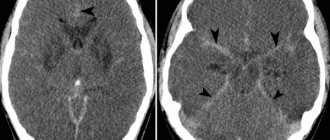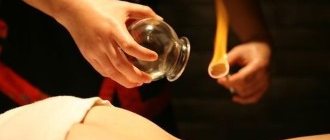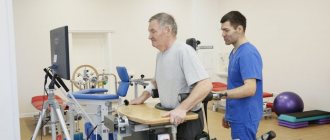A pinched sciatic nerve causes pain.
It is observed in an uncomfortable sitting position, during pregnancy or excessive physical activity.
If not properly treated, it can cause serious complications.
Treatment may include medications, physical therapy, and exercises for sciatic nerve inflammation.
The last point is an important part of therapy, which allows not only to relieve inflammation, but also to strengthen the muscles in this area to prevent re-inflammation.
What is sciatica?
This disease is a syndrome manifested by acute pain in the area of the sciatic nerve . At the site of the nerve itself or in the lower back, compression of the spinal cord roots occurs. There are many reasons for pinched nerve endings in the spine, and therefore the manifestations of the syndrome are very diverse.
The term sciatica refers to a syndrome, not a disease. The pathology itself is called lumbosacral radiculitis. Depending on the causes of manifestation, there are other options for the name of sciatica: radiculopathy, radiculoischemia.
Most people do not know about sciatica, its symptoms and treatment. The human body is a complex mechanism that consists of tissues and many nerve networks.
When the sciatic nerve is pinched, the pain spreads to the entire leg
The sciatic nerve is the longest . It is formed by 5 pairs of spinal cord roots. If even one gets pinched, rather unpleasant symptoms immediately appear. This compression of the nerve ending is called sciatica.
Signs of a pinched sciatic nerve
The sciatic nerve is one of the largest in the human body. It is formed from six nerve roots, originates in the region of the 4th and 5th lumbar vertebrae and, passing through the greater sciatic foramen, stretches to the popliteal fossa. The main sign of a pinched sciatic nerve is pain. In this case, it is the intensity of this pain that matters in order to determine how much the sciatic nerve suffers.
Anyone can do a simple test at home to see if they have signs of a pinched sciatic nerve. You need to bend forward and then straighten your back. If, at the moment of bending the torso, pain occurs in the back, which goes through the buttock and back of the thigh to the bottom of the leg, then there are definitely problems with the sciatic nerve. Neurologists and neuropathologists use several other tests. For example, the patient lies on his back on the couch and straightens his legs. Then the doctor begins to lift his leg and brings it to a 90-degree angle. If the sciatic nerve is inflamed or pinched, pain will certainly appear in the leg when lifting. The earlier the pain appears when lifting, the more complex the problem. In addition to pain, other signs indicate a pinched sciatic nerve:
- motor dysfunction;
- dysfunction of the pelvic organs;
- loss of sensation in the buttocks and back of the legs.
Basic principles of treatment
Complex therapy not only relieves pain, but also eliminates the causes that provoked the pinched nerve.
During the period of exacerbation of sciatica, when the pain is very severe, symptomatic treatment is carried out . To eliminate pain, various painkillers (Diclofenac, Ketanov), muscle relaxants and hormones are used. Antioxidants and vascular agents will help speed up the end of the attack, improving blood circulation and restoring the normal functioning of the affected tissues.
During remission, the pain disappears, but tissue nutritional disturbances and difficulties with movement remain . Therefore, maintenance therapy is necessary during this period.
For this purpose, physiotherapeutic procedures : massage, magnetic therapy, diadynamic currents, darsonvalization. They relax the muscles and eliminate pinched nerves, allowing for complete healing. These procedures eliminate recurrences of painful attacks.
Maintenance therapy also includes taking metabolic drugs, vitamins and antioxidants that restore blood microcirculation. If sciatica is caused by an infectious disease, then antibiotics may be used.
As a last resort, surgical treatment is performed. For example, with a hernia or tumor in the spine. Surgery is necessary if sciatic nerve compression has caused defecation disorder or urinary incontinence.
Causes
Compression of the sciatic nerve can occur in a variety of different cases. This can occur due to injuries to the legs, pelvis and back, during pregnancy, prolonged immobility, pinched nerves by fibrous cords or neoplasms, etc.
Most often, sciatica becomes a complication of various spinal diseases, including:
- lumbar osteochondrosis - degeneration of large intervertebral discs of the lumbar spine is the main prerequisite for the development of other spinal diseases and pinching of nerve fibers of different sizes;
- the formation of intervertebral hernias is the most common complication of osteochondrosis, manifested by protrusion of the disc, which leads to compression and damage to the spinal roots;
- spondylolisthesis – displacement of the vertebrae relative to the underlying one by different amounts, which can provoke pinching of the nerve roots;
- facet syndrome - nerve fibers are pinched in the narrow natural openings of the spine as a result of deformation of the vertebrae, the formation of osteophytes, or other disorders.
Another common cause of sciatica is spasm of the piriformis muscle located in the buttock. Since the sciatic nerve passes through it, an increase in its tone leads to stretching and irritation of the nerve fiber, which immediately results in severe pain.
Other prerequisites for the development of sciatica include:
- excessive physical activity;
- spinal tumors of various natures from hemangiomas to malignant neoplasms;
- arthritis;
- thrombosis of blood vessels;
- hypothermia and the development of inflammatory processes in anatomical structures adjacent to the spine at the level of the lumbosacral region;
- infectious gynecological and other diseases, including influenza, tuberculosis, typhoid fever, sepsis (released toxins affect the sheath of the sciatic nerve);
- spinal deformities (scoliosis, etc.).
Exercise therapy for sciatica
Patients often ignore or underestimate prescribed exercises for sciatica. Many patients find that medications are more effective than therapeutic exercises. This opinion is clearly erroneous.
A set of properly selected exercises improves blood circulation, relieves inflammation and activates metabolism . Therapeutic exercises speed up recovery, and pain can be relieved in a few days.
In addition, other spinal problems that may cause sciatica are eliminated. All exercises are performed only in the absence of pain; during periods of exacerbation, training is strictly prohibited. The main thing is to do the exercises correctly.
Doing exercises is prohibited during the acute phase of sciatica. For gymnastics to be effective, you should adhere to certain recommendations:
- It is better to master the complex under the supervision of a doctor.
- Exercises will be beneficial if done twice a day.
- All exercises for sciatica are done on a hard surface.
- During an exacerbation of the disease, breaks are allowed, but then you need to continue performing the complex, taking into account your state of health.
- Gymnastics should be done regularly. If there is no desire or strength, then you should not cancel the training, you need to do at least 2-3 exercises at half strength.
If the disease is in the acute phase, then the exercises are not performed until the pain disappears.
Physical activity is also undesirable in some pathologies:
- Mental disorders.
- Epilepsy (frequent seizures).
- Serious spinal injuries.
- Oncology.
- Heart diseases.
- Viral infections that are accompanied by fever.
Due to these restrictions, you should first consult a doctor or undergo a full examination.
Video: “The most effective exercise for pinched sciatic nerve”
Find out more about spinal neuralgia:
- Radicular syndrome with osteochondrosis in the cervical spine
- You can find out how to give injections for sciatica here
- A list of ointments for sciatica is posted on the page
When is the best time to see a doctor and which one?
When talking about any disease, even the simplest one, doctors advise us to make an appointment and undergo examination as soon as possible. In the case of a pinched sciatic nerve, the situation is absolutely the same. As soon as the first pain appears in the back, buttocks, or leg, you should definitely consult a doctor. To begin with, you can visit a therapist or immediately make an appointment with a neurologist or neurologist.
Clinic "Energo" in St. Petersburg offers you a wide range of medical services. Including from us you will receive qualified assistance from a neurologist.
and other specialists who deal with the problem of pinched sciatic nerve, as well as other pathologies associated with the central and peripheral nervous system. Our clinic is equipped with modern diagnostic equipment. X-ray, CT, MRI - you can undergo all these and other examinations at Energo. In this case, you will not have to wait long in line. You can make an appointment at a time convenient for you by phone. Doctors at the Energo clinic will be able to select for you the optimal set of exercise therapy and gymnastics to relieve pinched sciatic nerves, which you can perform at home.
Exercise technique
Did you know that...
Next fact
If you perform the exercises correctly, gymnastics can completely replace drug therapy. All movements of the complexes are physiological and natural, so there will be no fatigue or sprains .
There are many exercises for inflammation of the sciatic nerve, and they are divided into certain groups.
In a lying position:
- Pulling your knees to your chest while lying on your back. Perform at least 10 times.
- Lying on your side, stretch your legs as far as possible. Then bend both legs and pull them towards your chest, then straighten. Do the same 10 times.
- Lie on your stomach. Palms near shoulders. Straightening your arms, stretch your back as much as possible, looking up. Make a short delay and return to your previous position. For beginners, 5 approaches will be enough, but over time you can increase to 15.
- Lie on your back. Pull your feet towards your buttocks. Arms crossed over chest. As you inhale, you should raise your torso, and as you exhale, lower it. Performed 15 times.
Sitting:
- Sit on the floor and stretch your legs forward. Spread your arms to the sides (at shoulder level) and bring them back, trying to connect your shoulder blades. Movements should be made smoothly, without jerking. Repeat at least 5 times.
- From a sitting position (arms extended upward), slowly lie on your back. Then raise your legs to a right angle. The lower back should not lift off the floor, as this will place excessive stress on the spine.
- Sit on a chair. Place your hands on the back of your head and make slow turns with your body.
Standing:
- Feet shoulder-width apart, back as straight as possible. Raise your right hand and lean to the left. The arm and torso should be parallel to the floor. Then return to the starting position and lean to the right.
- Hands on the belt. You need to take turns raising your straight leg. It doesn’t have to be high, you should focus on your feelings.
- Place your feet as wide as possible. Bend your knees (“rider pose”) and shift your weight to each leg in turn. This exercise improves blood circulation in the pelvic area.
Gymnastics for the prevention of sciatica
All exercises are an excellent way to prevent sciatica . Regular implementation of the complex will prevent the sudden onset of a painful attack.
Video: “Exercises for pinched sciatic nerve”
Swimming
Swimming will help enhance the effect of treating a pinched sciatic nerve. Exercising in water helps to relax muscles as much as possible, as well as strengthen them. After just a few swimming sessions, you will notice that the pain has decreased and it has become much easier to move. You can also perform special exercises in water:
- vigorous walking in water (the water level should be waist-deep or higher);
- swing your legs while also standing waist-deep in water;
- swing your legs with the knee bent, while you can hold on to the side of the pool or the buoys.
Exercises for acute back pain
With sciatica, lumbago (lumbago) often occurs . To relieve severe pain, there are two exercises that eliminate pain and restore motor activity.
- You need to stand at a horizontal surface, which should be at pelvic level. For example, a table or a couch. Slowly lie down on it with your body and relax well. While inhaling, inflate your stomach for 5 seconds, then exhale as much as possible. Repeat no more than 3 times.
- Take a position on all fours. The back should not bend. Relax your neck and lower your head. Inhale with your stomach (slow), hold for 5 seconds, exhale completely. After performing this breathing exercise 10 times, a person will notice how the pain recedes.
In order not to suffer from acute pain due to sciatica, it is advisable to visit the pool , take long walks, and ride a bicycle. I would recommend doing yoga, but with an experienced instructor.
Signs of a problem
If a nerve is pinched, you may experience aching, dull, sharp, unbearable pain in the lumbar region. It usually extends along the entire length of the leg, often down to the toes. You may experience tingling, numbness, and burning throughout the entire nerve bundle.
During muscle tension, sudden movements, coughing, the pain syndrome intensifies and hinders a person’s movements.
There are difficulties with movement, pain develops in a sitting or standing position.
There is lameness in one or both lower limbs.
Characteristic signs of the disease include:
- Numbness of the limbs;
- Loss or increase of sensitivity;
- Inability to move limbs;
- Dry skin.
Seeing a doctor immediately will help relieve these symptoms.
If you have problems urinating and holding in feces, or your body temperature rises to 38 degrees or higher, this may be a sign of complications.
When redness or swelling is noticeable on the back, this indicates the presence of inflammation.
Remember! A timely visit to a neurologist will help avoid complications.
Exercises according to the Bubnovsky system
To eliminate sciatica, a special complex has been developed aimed at toning the spinal muscles and normalizing joint mobility:
- "Cat" . You need to get on all fours and bend your back down as you inhale, and arch your back up as you exhale.
- "Pumping" . In the same position, do push-ups from the floor. Inhale - bend your arms, exhale - straighten them.
- "Pulling" . Lie on your back, bend your knees, and clasp your hands behind your head. As you exhale, touch your elbows to your knees, and while inhaling, return to the starting position.
- "Bridge" . Performed while lying on your back. As you exhale, the lower back rises, and as you inhale, it lowers.
An example of how to do the cat exercise correctly
Diagnostics
A neurologist diagnoses and treats sciatica. It is this specialist who should be contacted if any of the above symptoms occur. Already during the first appointment, based on the patient’s complaints and examination, the doctor may suspect compression of the sciatic nerve. But in order to find the most effective treatment, you need to find out why this happened. For this purpose, the patient is prescribed a set of studies, thanks to which the condition of the intervertebral discs, joints, bones, etc. can be assessed.
Therefore, as part of the diagnosis of sciatica and the causes of its occurrence, the following are used:
- X-ray of the sore leg, sacrum and lower back - the results of the study show the condition of the vertebrae and partly the intervertebral discs;
- MRI – provides comprehensive information about the condition of the intervertebral discs and spinal cord;
- CT is an informative method that allows you to detect pathologies of the sacrum and lumbar vertebrae;
- Electroneuromyography – provides data on the quality of transmission of nerve impulses to the muscles of the lower extremities and their contractility.
The most informative method for diagnosing diseases of the cartilage tissue from which intervertebral discs are formed, as well as pathologies of the spinal cord, is MRI. It is this method that allows you to thoroughly examine the discs, assess their size, position, and detect the slightest hernia and other disorders.
What exercises are contraindicated
Therapeutic exercises for sciatica always begin with a warm-up. Then they do stretching, gradually making the movements more difficult.
What exercises are prohibited to perform with this disease? Do not approach the bar under any circumstances . Excessive stress will further compress the intervertebral discs and can completely destroy them.
What not to do:
- Tilts and turns with weight . Friction occurs between the vertebrae, and this leads to disc injury.
- It is forbidden to squat with weight if the simulator is set to a rigid trajectory of movement, which does not always correspond to the anatomical structure of the spine.
Oddly enough, the most harmful thing for the spine is lying for long periods of time. To avoid pain in the lumbar region, the spinal column must have a strong muscular corset.
Video: “What exercise therapy exercises to do for sciatic neuralgia”
Pinching symptoms
Doctors consider several syndromes that indicate that the patient has a pinched nerve.
- Lesera – straight leg does not rise;
- Sikara – pain intensifies if a person bends the foot;
- landing - it is impossible to take a sitting position yourself.
It hurts to walk and squat, but if you lie down or sit with your legs spread wide apart, it goes away. Signs of inflammation and pinching of the sciatic nerve are quite expressive, but they can still be confused with other diseases:
- spondylitis;
- myeloma;
- ankylosing spondylitis;
- phlebothrombosis;
- arterial insufficiency.
Contraindications
Yoga for sciatica is not difficult. But it will be easier for those who have some skills in the classroom. Beginners can consult with experts. Classes are not recommended for the following problems:
- Blood diseases.
- During exacerbations of infectious diseases.
- After recent strokes and heart attacks.
- For oncology.
- For epilepsy.
- For tuberculosis.
Other contraindications include the postoperative period and severe pain. If discomfort occurs, you should stop training.
Yoga will help with an integrated approach. This technique will tone the muscles and make them more elastic.
Nerve diseases of the foot and ankle
Compression of the deep peroneal nerve was first described by Thompson in 1960, and in 1968 Marinacci named the condition anterior tarsal tunnel syndrome.
How does nerve compression occur?
The deep peroneal nerve may be compressed at several levels. The most common is anterior tarsal tunnel syndrome, which is compression of the deep peroneal nerve under the inferior extensor retinaculum. Compression by dorsal osteophytes of the talonavicular joint and the intermetatarsal bone (an accessory bone located between the bases of the 1st and 2nd metatarsals) has previously been described in runners.
Causes of nerve compression
The cause of the syndrome is often trauma. Many patients have a history of multiple injuries to the ligamentous apparatus of the ankle joint. Wearing tight shoes or ski boots is considered a provoking factor. Recreational runners may sometimes hide their house key in their shoe lacing when leaving the house; this key can become a source of external compression on the deep peroneal nerve. External compression of the nerve can be observed in athletes performing abdominal exercises while fixing their feet under a metal bar. Pressure on the nerve can be exerted by bone fragments from fractures or osteophytes of the distal end of the tibia, talus, scaphoid, cuneiform, or base of the metatarsals. The source of neuropathy of the deep peroneal nerve may be swelling of the surrounding tissues or the articular ganglion.
Finally, recently there has been an increase in the number of cases of deep peroneal nerve injuries associated with total ankle replacement, which uses an anterior approach, which involves significant mobilization of the neurovascular bundle and subsequent suturing of deep tissue layers, incl. over the deep peroneal nerve.
Who is predisposed to peroneal neuralgia?
Compression of the deep peroneal nerve is most often seen in runners, but can also occur in dancers and people whose feet are subject to compression or hyperextension for one reason or another.
Symptoms of nerve damage
Patients with deep peroneal neuralgia complain of pain in the dorsum of the foot, which can be reflected in the first interdigital space. As with other nerve compression syndromes in the foot and ankle area, it is necessary to exclude other causes of this pain syndrome, in particular, radicular syndrome emanating from the spine. When collecting anamnesis, attention should be paid to such provoking factors as wearing tight shoes or certain types of physical activity (for example, abdominal exercises, in which patients rest the front surface of the ankle joints against a metal stop). A history of foot and ankle injuries or chronic instability is important. When a nerve is compressed, patients often describe increased pain at night.
Conservative treatment
Conservative treatment includes modification of footwear to relieve external pressure on the dorsum of the foot and ankle, and modification of physical activity to activities that do not cause or worsen existing symptoms. As with superficial peroneal neuralgia, ankle braces can be used to relieve pain associated with joint instability. Local administration of glucocorticosteroids may be effective.
Surgery
The operation is performed under regional anesthesia at the level of the ankle joint.
The level of nerve compression is usually located at the anterior aspect of the ankle joint, the dorsal surface of the talonavicular joint, or the first metatarsophalangeal joint. A skin incision is made at the required level.
Once the source of compression is identified, it is resected.
In cases where the main factor in the development of neuralgia of the deep peroneal nerve is instability of the ankle joint, one should think about appropriate reconstructive interventions on the ligamentous apparatus. If the patient is diagnosed with anterior compartment syndrome, fasciotomy is indicated.
Postoperative period
During the first 4-5 days after surgery, the patient moves using crutches and gradually, as tolerated, begins to put weight on the operated leg. With extended interventions, immobilization of the ankle joint continues for 2 weeks, after which the plaster splint is replaced with an orthopedic boot for another 2-4 weeks.
Results of the operation
Patients with compression of the deep peroneal nerve who underwent surgical decompression achieved satisfactory results in 80% of cases. Unsatisfactory results were usually associated with intrinsic nerve damage or neuropathies that contributed to or aggravated the manifestations of nerve compression and for which neurolysis was usually ineffective. The best treatment results can be expected in patients with nerve compression from underlying bony structures or osteophytes. If the cause of the disease is a foot injury associated with foot compression, the results will be less favorable.











